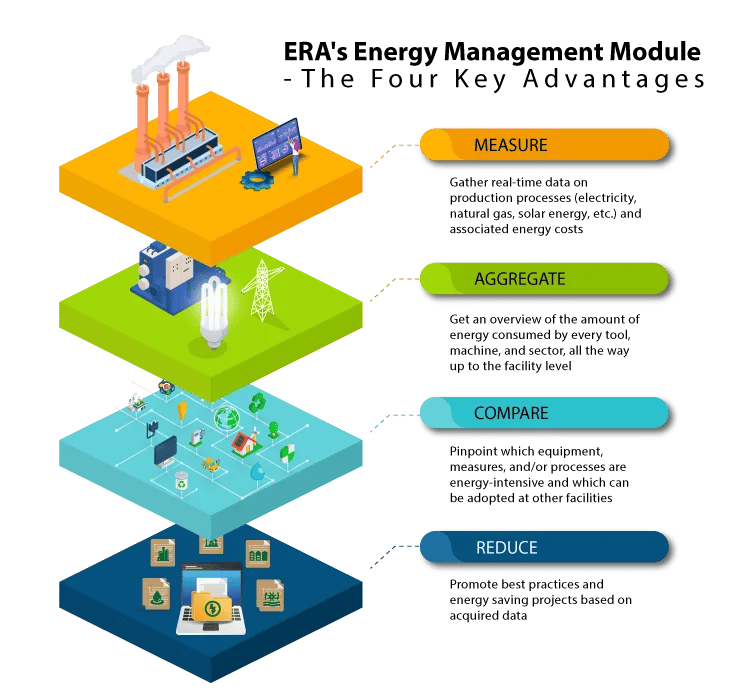Updated December 2024
Managing your energy consumption is an essential step in becoming a sustainable business. That’s true for both big companies and small facilities. However, these businesses don’t have to start from scratch. ISO 50001 provides a standardized methodology for measuring your energy consumption through individual processes and connecting that to your sustainability efforts.
So, what is ISO 50001? ISO 50001 originated in 2011 as the inaugural standard for energy management systems (EnMS). It helps you carefully manage your energy usage throughout your processes to identify weak links in your energy chain and identify opportunities to save money or implement improvements.
The energy ISO standard underwent an update in 2018; the current version is ISO 50001:2018. This updated version includes revisions to make implementing the standard more accessible to small and medium-sized enterprises (SMEs). It also adapts the standard to ISO’s Annex SL high-level structure to allow easy integration with all your ISO standards, such as ISO 9001 and ISO 14001.
While the potential energy and cost savings will differ for every business, if implemented correctly, the ISO 50001 standard can offer enterprises major savings.
The energy management standard follows a similar structure to that of ISO 14001. Both are grounded in the ISO’s PLAN-DO-CHECK-ACT system to create a continual improvement cycle. That means you’ll always seek ways to improve energy usage and perpetually reduce operating costs.
The ISO 50001 Cycle
Like the ISO 14001 standard, ISO 50001 should involve all levels of your business, including environmental specialists, executives, and those involved with your everyday manufacturing processes.
Here are the basics of the ISO 50001 structure:
PLAN
- Do an energy review & establish a baseline for your energy consumption.
- Set objectives and targets you want to reach in your energy usage.
- Develop action plans to take advantage of energy opportunities.
- Define your Energy Performance Indicators (EnPIs).
DO
- Delegate tasks to relevant team members.
- Implement the action plans you created in the planning stage.
CHECK
- Monitor your processes and measure your energy usage.
- Check your results against the targets and objectives you set.
- Report and communicate the results (particularly with key decision-makers).
ACT
- If you’ve reached your goals, set and develop new ones to continually improve.
- If you haven’t achieved your targets, determine why and take action to fix the issues.
ISO 50001 & Sustainability
Implementing ISO 50001 isn’t just a great way to reduce operating costs. It’s also an excellent way to contribute to your business’s overall sustainability plan. No successful environmental sustainability plan is complete without a thorough energy consumption reduction element, including introducing environmental and energy key performance indicators (KPIs).
Using ISO 50001 will help you best plan to maximize your renewable energy sources or find more energy-efficient equipment to complete the same tasks. Even if you haven’t reached a stage where you’re ready to start making those changes, using ISO 50001 will give you concrete energy usage data that makes for excellent sustainability report material and is helpful during decision-making.
ISO 50001 can also dramatically affect your air and greenhouse gas (GHG) emissions if you use it to reduce your overall energy usage or switch to more renewable sources. You’ll be able to minimize GHGs associated with your energy providers, which can make a big difference in carbon footprint reporting, both mandatory and voluntary.
In addition, ISO 50001 also helps you manage the energy consumption related to your entire supply chain. Creating a more sustainable supply chain is one of the most efficient ways of transforming your business into a more sustainable enterprise.
Companion Standards to ISO 50001
Like many other ISO standards, companion standards exist alongside ISO 50001 to guide companies in implementing their energy management systems. With these, companies can better overcome some of their specific energy-related challenges.
ISO 50002: Energy Audits
ISO 50002 outlines specific process requirements for carrying out energy audits to evaluate energy performance. It provides the necessary principles for organizations of all kinds to plan and carry out energy audits, including key deliverables.
ISO 50003: Energy Management Systems
This standard is intended not for organizations implementing energy management systems but for those providing audits and certification. ISO 50003 outlines requirements for documentation, audits, and personnel involved in ISO 50001 certification and compliance.
Implementing an ISO 50001 Compliant Energy Management System
ISO 50001 lays out requirements for a proper energy management system. However, organizations can go about meeting those requirements in many different ways. Some choose to tackle those objectives by creating their own data management and reporting processes, relying on in-house software development, spreadsheets, and manual document handling.
Going it alone to implement your energy management system can be time and resource-intensive, and creating any in-house software solution can carry excessive costs. Instead, relying on a ready-made energy management system that meets and exceeds ISO 50001 requirements could be the best way to reduce your overall ISO 50001 certification costs.
ERA’s Energy Management & Reporting Software gives your team the tools to pinpoint efficiencies, track utilities, and achieve real savings. This all-in-one platform lets you tackle critical aspects of energy management, including benchmarking, tracking, reporting, auditing, and continuous improvement. Not only can you meet ISO 50001 requirements, but you’ll be able to make real improvements in efficiency, sustainability, and savings.
Achieving ISO 50001 Certification
Like many ISO standards, certification is not necessarily required to get all the benefits of implementing ISO 50001. However, getting certified with the help of a professional certification organization will likely increase the speed and ease with which those benefits occur.
You’ll also find it easier to manage your energy consumption if you have a system to monitor your energy usage for every process automatically. A good environmental management system (EMS) or ISO 14001 will help you capture the data needed for ISO 50001.
While ISO creates the standard, they don’t handle certification or compliance. Various third-party organizations provide ISO 50001 certification throughout different regions, including NQA, BSI Group, DEKRA, EAS, and more.
If you plan on becoming a sustainability leader, it may be time to consider ISO 50001 certification to manage the energy consumption element of your overall efforts. Schedule a discovery call with one of our project analysts to discover how ERA’s Energy Management & Reporting Software can meet your organization’s unique needs.

September 10, 2012



Comments